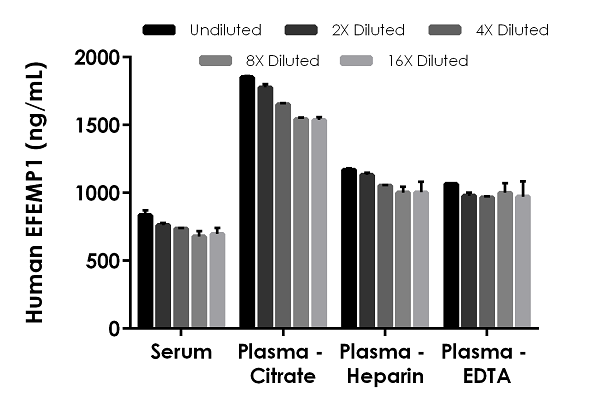Human EFEMP1 ELISA Kit (Fibulin-3) (ab269552)
Key features and details
- One-wash 90 minute protocol
- Sensitivity: 42 pg/ml
- Range: 62.5 pg/ml - 4000 pg/ml
- Sample type: Cit plasma, EDTA Plasma, Hep Plasma, Serum
- Detection method: Colorimetric
- Assay type: Sandwich (quantitative)
- Reacts with: Human
Overview
-
Product name
Human EFEMP1 ELISA Kit (Fibulin-3)
See all EFEMP1/Fibulin-3 kits -
Detection method
Colorimetric -
Precision
Intra-assay Sample n Mean SD CV% Serum 8 9.5% Inter-assay Sample n Mean SD CV% Serum 3 9.5% -
Sample type
Serum, Hep Plasma, EDTA Plasma, Cit plasma -
Assay type
Sandwich (quantitative) -
Sensitivity
42 pg/ml -
Range
62.5 pg/ml - 4000 pg/ml -
Recovery
Sample specific recovery Sample type Average % Range Serum 99 90% - 106% Hep Plasma 96 88% - 104% EDTA Plasma 104 93% - 110% Cit plasma 97 86% - 105% -
Assay time
1h 30m -
Assay duration
One step assay -
Species reactivity
Reacts with: Human -
Product overview
Human EFEMP1 ELISA Kit (Fibulin-3) (ab269552) is a single-wash 90 min sandwich ELISA designed for the quantitative measurement of EFEMP1 (Fibulin-3) protein in serum, cit plasma, edta plasma, and hep plasma. It uses our proprietary SimpleStep ELISA® technology. Quantitate Human EFEMP1 (Fibulin-3) with 42 pg/ml sensitivity.
SimpleStep ELISA® technology employs capture antibodies conjugated to an affinity tag that is recognized by the monoclonal antibody used to coat our SimpleStep ELISA® plates. This approach to sandwich ELISA allows the formation of the antibody-analyte sandwich complex in a single step, significantly reducing assay time. See the SimpleStep ELISA® protocol summary in the image section for further details. Our SimpleStep ELISA® technology provides several benefits:
- Single-wash protocol reduces assay time to 90 minutes or less
- High sensitivity, specificity and reproducibility from superior antibodies
- Fully validated in biological samples
- 96-wells plate breakable into 12 x 8 wells stripsA 384-well SimpleStep ELISA® microplate (ab203359) is available to use as an alternative to the 96-well microplate provided with SimpleStep ELISA® kits.
-
Notes
EFEMP1, EGF-containing fibulin-like extracellular matrix protein 1, is a secreted extracellular glycoprotein in the fibulin family. It is a key regulator of cell-to-cell and cell-to-matrix adhesion. It is currently under investigation as a pharmacological target for a host of cancers. The antibodies for this kit were raised against recombinant protein representing the mature full-length human protein.
-
Platform
Pre-coated microplate (12 x 8 well strips)
Properties
-
Storage instructions
Store at +4°C. Please refer to protocols. -
Components 1 x 96 tests 10X Human EFEMP1 (Fibulin-3) Capture Antibody 1 x 600µl 10X Human EFEMP1 (Fibulin-3) Detector Antibody 1 x 600µl 10X Wash Buffer PT (ab206977) 1 x 20ml Antibody Diluent 4BI 1 x 6ml Human EFEMP1 (Fibulin-3) Lyophilized Recombinant Protein 2 vials Plate Seals 1 unit Sample Diluent NS (ab193972) 1 x 50ml SimpleStep Pre-Coated 96-Well Microplate (ab206978) 1 unit Stop Solution 1 x 12ml TMB Development Solution 1 x 12ml -
Research areas
-
Function
Binds EGFR, the EGF receptor, inducing EGFR autophosphorylation and the activation of downstream signaling pathways. May play a role in cell adhesion and migration. May function as a negative regulator of chondrocyte differentiation. In the olfactory epithelium, it may regulate glial cell migration, differentiation and the ability of glial cells to support neuronal neurite outgrowth. -
Tissue specificity
In the eye, associated with photoreceptor outer and inner segment regions, the nerve fiber layer, outer nuclear layer and inner and outer plexiform layers of the retina. -
Involvement in disease
Defects in EFEMP1 are a cause of Doyne honeycomb retinal dystrophy (DHRD) [MIM:126600]; also known as malattia leventinese (MLVT) (ML). DHRD is an autosomal dominant disease characterized by yellow-white deposits known as drusen that accumulate beneath the retinal pigment epithelium. -
Sequence similarities
Belongs to the fibulin family.
Contains 6 EGF-like domains. -
Cellular localization
Secreted > extracellular space. Secreted > extracellular space > extracellular matrix. Localizes to the lamina propria underneath the olfactory epithelium. - Information by UniProt
-
Alternative names
- DHRD
- Doyne honeycomb retinal degeneration
- DRAD
see all -
Database links
- Entrez Gene: 2202 Human
- Omim: 601548 Human
- SwissProt: Q12805 Human
- Unigene: 76224 Human
Images
-
SimpleStep ELISA technology allows the formation of the antibody-antigen complex in one single step, reducing assay time to 90 minutes. Add samples or standards and antibody mix to wells all at once, incubate, wash, and add your final substrate. See protocol for a detailed step-by-step guide.
-
The EFEMP1 standard curve was prepared as described in Section 10. Raw data values are shown in the table. Background-subtracted data values (mean +/- SD) are graphed.
-
The concentrations of EFEMP1 were measured in duplicates, interpolated from the EFEMP1 standard curves and corrected for sample dilution. Undiluted samples are as follows: serum 1:400, plasma (citrate) 1:800, plasma (heparin) 1:400, plasma (EDTA) 1:400. The interpolated dilution factor corrected values are plotted (mean +/- SD, n=2). The mean EFEMP1 concentration was determined to be 742 ng/mL in serum, 1672 ng/mL in plasma (citrate), 1072 ng/mL in plasma (Heparin), and 997 ng/mL in plasma (EDTA).
-
The concentrations of EFEMP1 were measured in duplicates, interpolated from the EFEMP1 standard curves and corrected for sample dilution; Undiluted CSF is 2%. The interpolated dilution factor corrected values are plotted (mean +/- SD, n=2). The mean EFEMP1 concentration was determined to be 91 ng/ml.
-
To learn more about the advantages of recombinant antibodies see here.













